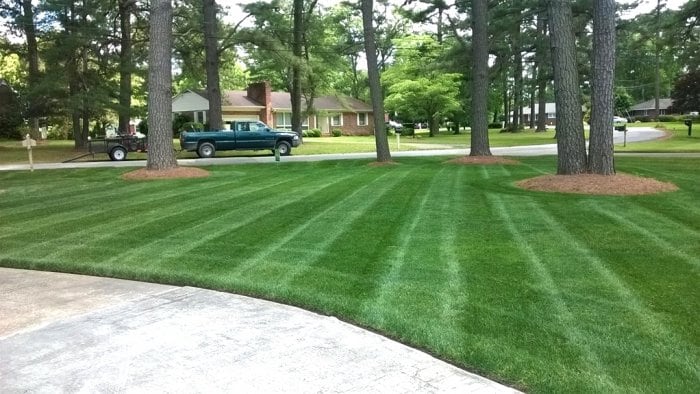
No one wants a brown or patchy lawn — but almost everyone makes mistakes when caring for their lawn, which result in damage or death to the grass. Unfortunately, though most homeowners have a lawn to care for, few bother learning the proper ways to keep grass growing and thriving. If you don’t want to do unnecessary harm to your lawn, read on for the most common lawn care mistakes and how to fix them.

Drowning
Grass needs water — but there is such a thing as too much of a good thing. The soil beneath grass can become oversaturated with water, which can cause a whole host of problems. Most often, an overabundance of water increases the likelihood for grass to become infested by fungus, which thrives in moist conditions. The fungus will kill and devour your lawn, causing dead patches in distinctive patterns. However, even if you don’t have fungus, extra water isn’t good — it can wash away any nutrients in the soil and prevent your grass from getting other essentials like sunlight or air.
Parching
Then again, you don’t want to deprive your lawn of water, either. In general, experts advocate for giving your lawn between 1 and 1.5 inches of water per week, which should take into account any precipitation in your area. However, if you live in a dry region or if your soil is sandy and drains water swiftly, you might need to provide more. Different watering methods make more sense for different lawn types in different regions, so you should read up on irrigation here: https://www.greenerhorizon.com/pros-and-cons-of-different-irrigation-systems/
Starving
Just as you wouldn’t do well if you didn’t have any food for a prolonged period of time, your grass needs to be fed on a regular basis. Your grass needs three macronutrients, nitrogen, potassium and phosphorus, as well as a bevy of micronutrients like manganese and zinc. Over time, your grass will strip the soil of any existing nutrients and start to starve. You should get in the habit of feeding your lawn at least once per week, in either the fall or spring,
Scalping
Many lawn owners are tempted to mow their grass as close as possible to the soil — after all, if you mow extra short now, you won’t have to mow as much later, right? Actually, cutting your lawn too short is dangerous for your grass because it removes a significant amount of the grass’s energy-catchers, i.e. leaves. Additionally, blades of grass shade the crown and roots, protecting it from the heat and preventing necessary moisture from leaving the soil. Cool-season grasses (like bluegrass, fescue and ryegrass) need to be between 3 and 4 inches tall, while warm-season grasses (like Bermuda, zoysia and St. Augustine) tend to prefer between .5 and 1 inch. You can learn more about different types of grasses and their needs here: https://www.trugreen.com/lawn-care-101
Ripping
Then again, you shouldn’t mow your lawn at all if your mower blades are dull. Dull blades don’t neatly slice through your grass; instead, they pull, tear and rip, causing jagged edges that your grass will struggle to heal. The longer it takes your grass to repair the damage from mowing, the more likely your lawn is to suffer from various lawn diseases. That’s why you should get your mower blades professionally sharpened at least once per year.
Compacting
Believe it or not, grass isn’t ideal for recreation. While some amount of foot traffic can be tolerated by some kinds of grass, overuse of your grass results in compaction of the soil. Hard, compacted soil prevents your lawn’s roots from reaching water and nutrients, and it can also stop the grass from getting air, too. You can relieve compaction by using a coring aerator once or twice per year (depending on your lawn’s use) — or by hiring professionals to do so.
Guessing
The number-one biggest mistake that people make with regards to their lawns is assuming that they can stumble onto the proper care. Grass is a living organism, like your pets or your kids; it requires precise care to maintain proper health, and it’s unlikely that you’ll ever be able to guess what it needs. You should perform plenty of tests on your lawn and soil, so you can give it exactly the right thing and the right time — and so you can enjoy a beautiful, lush, green lawn.
Mistakes can be undone. Unfortunately, with your lawn, it could take months or years for the damage to be repaired. The key is learning from your mistakes and working hard to practice proper lawn care — or hiring someone who knows what they’re doing.

Christine Kelley is a dedicated home blogger who has been blogging for over six years. She covers everything home related. Christine also loves writing posts about her travels to Europe with her husband and two children.




